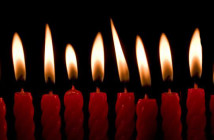HOW THE HELL DID WE GET HERE?
LOOKING BACK ON 5 YEARS OF BIG RED & SHINY
On February 15th, 2009, Big RED & Shiny celebrates our fifth year online and our hundredth issue. It is impossible to express how proud we are of this achievement, or how excited we are to embark on the next five years of arts coverage for New England (and beyond). Yet, anniversaries are a time for looking back and learning from the past, so here as we pass from two- to three-digit issue numbers, we pause to consider what has come before.
For me, it is the design of Big RED & Shiny issues that tells the tale. As publisher, I designed 99 out of the past 100 issues, and I can trace the history of our little pink website in each and every graphic, typeface, color and style. Big RED & Shiny has been growing and evolving since it was first conceived, and our archives tell our history in many ways.
In the beginning, there was no Big RED & Shiny. As an idea, a hope for discussion around art in Boston, it grew out of conversations at the old Oni Gallery, the Berwick, and among the students and faculty of the Museum School. It took about a year of conversations to arrive at a formula: artists discussing work they found interesting, with an editor or moderator to ensure a certain standard of quality, published periodically in digests to group ideas and context. To be honest, we've never actually sat down and defined our standards of quality, it is a floating measure applied by each editor to each writer in individual ways. We are open to anyone who wants to submit, and only ask for thought-provoking conversation and illuminating discourse.
The name Big RED & Shiny is based on an art school joke that I've heard told many ways at several schools. The version I heard at the Museum School was "If your art is bad, make it big; if you want people to pay attention, make it red; if you want it to sell, make it shiny." To say that someone made "big red and shiny art" was an insult; it implied that they were following trends and more concerned with the market than quality art. Jenn Schmidt revived it during our quest for a name, and it stuck.
The design of our first nine issues is based on a style I worked out with Michael Brodeur, the former editor of the Weekly Dig and now arts editor of the Boston Phoenix. Brodeur wanted something that melded incongruous fonts, creating an awkward design. Our main font, a free download called Fatslab, remains to this day. Fatslab contains no punctuation, however, so our ampersand has always been set in Impact. Brodeur loved the Fatslab/Courier combination, which hung around for a while, but ultimately the more readable Arial won out. Brodeur is also the reason why the background is a slight pink.
Our first nine issues were, to be honest, a challenge. Sean Horton, who served as our first editor-in-chief, worked incredibly hard to find writers and set the tone of our publication. As publisher, I struggled to adapt the code and templates to meet the needs of the content, realizing quickly that our plans were not keeping up with the realities of the project. It was not until issue seven, Horton's last full issue, that I was able to contribute as a writer, as I was using all my free time to get the site functioning.
Issue ten was our first summer movie issue, as we struggled to find content during the dead zone of summer. The design was not all that different than previous issues, but it opened the idea that Big RED & Shiny could look any number of ways and that each issue could stand on its own as a design theme. Later Summer Movie issues pursued a summer beach theme (#25), an Indiana Jones theme (#45) and a Hitchcock theme (#67). Yet, even with this exciting knowledge, issues twelve and thirteen were based on the same old look. It wasn't until fourteen, our first Thanksgiving issue, that the look of Big RED & Shiny began to reflect the larger context in which the work was being shown and discussed. After issue fourteen, each Big RED & Shiny had its own look designed to evoke some aspect of the larger experiential context.
Issue seventeen, our Money issue, was created to accompany our first fundraiser at the Mills Gallery. "Big RED: Green" was a money-themed exhibition and art auction, with a performance by Jamie McMurry, that supported our early years. More recently, issue ninety-nine was designed to echo the promotional cards for the Boston Art Awards Ball held earlier this month. Issue twenty-one was our first Boston Cyberarts Festival issue, and is based on an old DOS video game. Issue twenty-three was the Air Jordans commemorative issue, an unintentional design crossover that Matthew Gamber caught. Issue twenty-six was deliberately the worst design ever, because we wanted to promote our competition to design an issue of Big RED... which only got one submission. Issue thirty features Stefano Pasquini's design for Big RED & Shiny.
After Sean Horton left for Vermont (and later New York) between issues seven and eight, Matthew Gamber took over as editor-in-chief. He has been in that job ever since, guiding the voice of this publication and quietly taking charge and making sure things work. If you hadn't already guessed, I'm the loud public face of Big RED & Shiny, making a fool of myself while Gamber actually ensures that the job is done right and every issue is the best it can be. Our current team of executive editors -- Micah Malone, Christian Holland and James Nadeau -- all date back to the earliest issues and have become integral voices in all aspects of our publication.
Big RED & Shiny has had a number of executive editors, and for issue thirty-five Rachel Gepner put together an "Art In Academia" issue which questioned how art is made and discussed in an overly academic environment like Boston. The feature piece was a series of questions sent to artists about art in academia, and the design was meant to be a playful look at academic discourse.
It's usually not hard to tell when an issue was launched, if you look at the design. Issues fourteen and thirty-one are Thanksgiving issues; issues fifteen, sixteen, fifty-three, fifty-five, seventy-five, ninety-four, ninety-seven and ninety-eight are winter issues; issuetwenty-five is clearly a summer issue, while twenty-eight, twenty-nine, fifty-one, seventy, seventy-one, seventy-three, ninety-one,ninety-two and ninety-four are all autumn themed. Issue eighty-nine celebrates Boston moving day; issue ninety-six is our only Christmas themed issue.
For this, our hundredth offering, we have a theme that is a throwback to the very first issue. It has been updated a little to reflect the many changes that Big RED & Shiny has made in the past half-decade, but also serves as a reminder of all the things we wanted to do with this project when we first embarked on this little pink website. Between then and now, through nearly 1400 articles and 400 blog posts, we've grown a lot.
So, what's in store for Big RED & Shiny? We're not saying (although, I will warn you to beware the Ides of March!). In the meantime, please blow out some candles and grab a slice of birthday cake. Happy Birthday to us!
Four years of Big RED birthday issues:
ANNIVERSARY: A YEAR IN REVIEW by MATTHEW NASH in issue #18
BACK TO THE (BIG RED) FUTURE by BIG RED STAFF in issue #36
BIG RED'S THIRD BIRTHDAY by MATTHEW NASH in issue #57
HAPPY BIRTHDAY! 4 YEARS AND COUNTING... by MATTHEW NASH in issue #77
All images are via the CakeWrecks blog.






